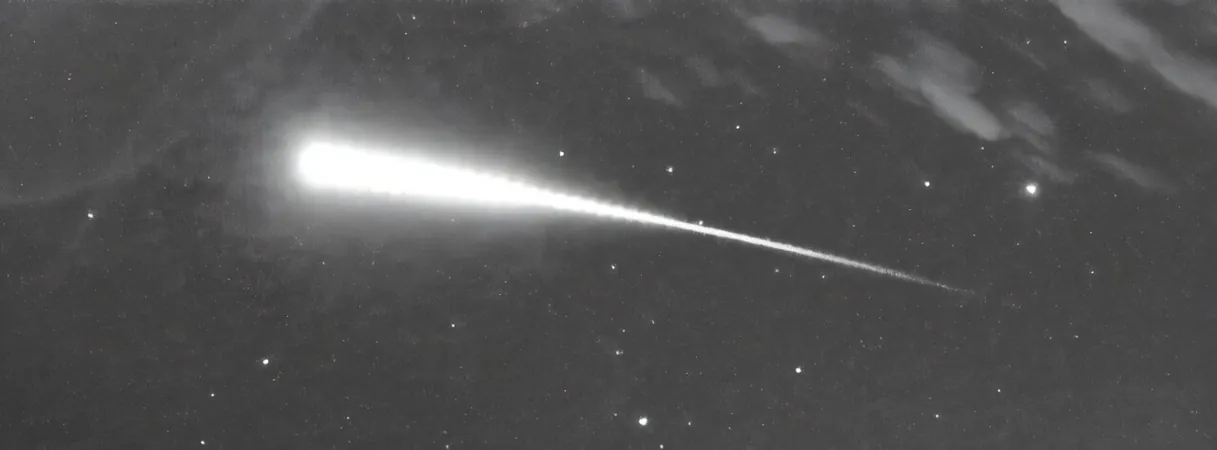
Astronomers Unveil 7 New 'Dark Comets' – The Secrets Behind These Cosmic Enigmas!
2024-12-12
Author: Mei
Introduction
In an exciting new discovery, astronomers have identified seven additional "dark comets," revealing an intriguing bifurcation among these mysterious celestial bodies. These planetoids exhibit asteroid-like appearances but behave similarly to comets, raising profound questions about their nature and origins.
The Confusion Between Asteroids and Comets
Traditionally, the difference between asteroids and comets has been relatively clear-cut. However, recent findings show a confusing overlap, particularly with the emergence of "main-belt comets," which are active asteroids capable of generating comet-like tails. In stark contrast, dark comets possess some comet-like characteristics but lack tails and seem to defy gravitational expectations. This peculiar behavior is defined by their ability to experience non-gravitational acceleration, suggesting that they may have an unexplained propulsion mechanism.
Unconventional Motion of Dark Comets
Davide Farnocchia from NASA's Jet Propulsion Laboratory emphasizes the unconventional motion of these dark comets, stating, "When you see that kind of perturbation on a celestial object... it usually indicates it's a comet, with volatile material outgassing from its surface. But in the case of dark comets, we couldn't find any signs of a tail."
Parallels with Interstellar Objects
Dark comets' enigmatic behavior has drawn parallels with the interstellar object 1I/'Oumuamua, which surprised scientists with its unexpected acceleration as it traversed our solar system without displaying any signs of outgassing. This resemblance further complicates our understanding of celestial dynamics, as both dark comets and 'Oumuamua exhibit similar, unexplained motion patterns.
Discovery of New Dark Comets
With this latest discovery, the total number of documented dark comets now stands at 14. Researchers led by Daryl Seligman from Michigan State University have started to observe and categorize them. Their analyses suggest two distinct types of dark comets: those lurking in the cold depths of the outer solar system and their smaller counterparts residing in the inner solar system, alongside the terrestrial planets.
Characteristics of Outer and Inner Dark Comets
The outer dark comets tend to be significantly larger, ranging hundreds of meters in diameter and follow more elliptical orbits akin to traditional comets. In contrast, the inner dark comets are tightly packed, with diameters often measuring just tens of meters. Astonishingly, these smaller entities exhibit circular orbits similar to those of planets, possibly hinting at their formation and evolutionary paths.
Remaining Questions and Speculations
Despite the profound advances in understanding, many questions remain. How did these dark comets arrive at their current locations? Preliminary studies indicate that the inner dark comets could have been nudged from their birthplace in the inner asteroid belt, while the outer ones' histories are still under investigation.
The Mystery of Water Ice
Adding further intrigue is the speculation regarding the content of water ice within these bodies. Historical models propose a "snow line" formed during the solar system's infancy, beyond which temperatures allowed ice to crystallize. It has been suggested that even dark comets from the inner solar system may contain water ice, potentially leading to their ability to outgas and create non-gravitational thrust.
Implications for Earth's History
Notably, the research by Seligman's team hints that up to 60% of near-Earth objects could be classified as dark comets. This raises compelling scenarios where dark comets could have been key players in delivering vital water resources to Earth eons ago, thereby aiding the emergence of life.
Conclusion
"Dark comets present an exciting new perspective in examining potential sources of life-sustaining materials on Earth," remarked Seligman. "The deeper we delve into their mysteries, the clearer our understanding of our planet’s origins will become." As explorers of the cosmos continue to unearth the secrets held within our solar system, the newfound classification of dark comets and their potential contributions to Earth's history promise to reshape our knowledge of planetary development and the very essence of life itself. Stay tuned, because the universe still has many secrets to share!



 Brasil (PT)
Brasil (PT)
 Canada (EN)
Canada (EN)
 Chile (ES)
Chile (ES)
 España (ES)
España (ES)
 France (FR)
France (FR)
 Hong Kong (EN)
Hong Kong (EN)
 Italia (IT)
Italia (IT)
 日本 (JA)
日本 (JA)
 Magyarország (HU)
Magyarország (HU)
 Norge (NO)
Norge (NO)
 Polska (PL)
Polska (PL)
 Schweiz (DE)
Schweiz (DE)
 Singapore (EN)
Singapore (EN)
 Sverige (SV)
Sverige (SV)
 Suomi (FI)
Suomi (FI)
 Türkiye (TR)
Türkiye (TR)